Introduction
Knowledge/Clinical Judgment
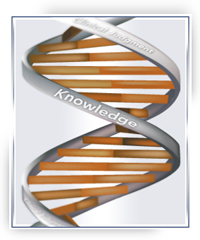 Nursing knowledge is the acquisition of facts and principles based on evidence and are considered to be the
foundation of reasoned action. There is no substitute for nursing knowledge when answering test items and
providing client care. Acquisition of knowledge occurs in the classroom, online, in clinical, and in response
to various other learning activities. There are two levels of thinking in relation to using nursing knowledge
- foundational and critical thinking.
Nursing knowledge is the acquisition of facts and principles based on evidence and are considered to be the
foundation of reasoned action. There is no substitute for nursing knowledge when answering test items and
providing client care. Acquisition of knowledge occurs in the classroom, online, in clinical, and in response
to various other learning activities. There are two levels of thinking in relation to using nursing knowledge
- foundational and critical thinking.
Foundational Thinking
- Foundational thinking is the ability to recall and comprehend information and concepts foundational to quality nursing practice. Recalling information involves being able to retrieve previously learned knowledge. Comprehending knowledge involves being able to understand the knowledge retrieved and verbalize or use it in some manner. "Understanding" is another term for comprehension.
Critical Thinking
-
Critical thinking is the term given to the thinking skills used when analyzing client issues and problems. These
thinking skills include interpretation, analysis, evaluation, inference and explanation. They are used to facilitate
a critical analysis of the client problem or issue and subsequently determine the most appropriate action to take.
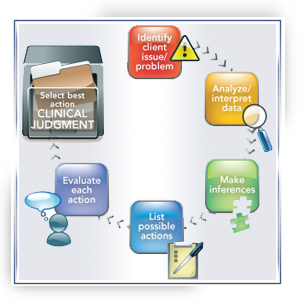 Clinical judgment is the decision made regarding the course of action to be taken and is based upon a critical
reflection of data when nursing knowledge is applied to a clinical situation. Your ability to make sound clinical
judgments will help ensure that your nursing care is safe, high in quality, and client-centered. The use of the
clinical decision-making process will help you analyze data and use your nursing knowledge to make sound clinical judgments.
Clinical judgment is the decision made regarding the course of action to be taken and is based upon a critical
reflection of data when nursing knowledge is applied to a clinical situation. Your ability to make sound clinical
judgments will help ensure that your nursing care is safe, high in quality, and client-centered. The use of the
clinical decision-making process will help you analyze data and use your nursing knowledge to make sound clinical judgments.
Clinical decision-making process
The clinical decision-making process helps walk you through an organized analysis of a client issue or problem and select an appropriate action to take in regard to its resolution. The steps of this process include:
- Identifying that a client issue or problem exists.
- Analyzing and interpreting relevant data.
- Making inferences based on this interpretation.
- Listing all possible actions that could be taken.
- Evaluating each action.
- Selecting the best action.
Clinical reasoning
Clinical reasoning is the mental process used when analyzing all the elements of a clinical situation and making a decision based on that analysis. Clinical reasoning supports the clinical decision making process by:
- Guiding the nurse through the process of assessing and compiling data.
- Selecting and discarding various bits of data based on their relevance.
- Making decision regarding client care based on nursing knowledge.
Priority-Setting Frameworks
Priority setting is the ability to use nursing judgment when making decisions about the rank order in which nursing actions should be taken. Priority-setting frameworks assist you to make decisions regarding priority findings, priority nursing actions, and the proper sequence of nursing actions. The ATI Helix of Success supports seven priority-setting frameworks that can be followed when using the clinical decision-making process to make a clinical judgment.
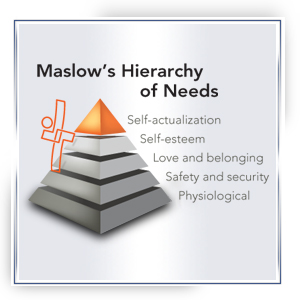 There are five levels of Maslow's Hierarchy of Needs - physiological, safety and security, love and belonging, self-esteem, and
self-actualization. In theory, the highest priority needs are those necessary for survival and make up the foundation of the
triangle. While this is usually the case, higher levels of the pyramid may compete with those at the foundation depending on
the specific client situation.
There are five levels of Maslow's Hierarchy of Needs - physiological, safety and security, love and belonging, self-esteem, and
self-actualization. In theory, the highest priority needs are those necessary for survival and make up the foundation of the
triangle. While this is usually the case, higher levels of the pyramid may compete with those at the foundation depending on
the specific client situation.
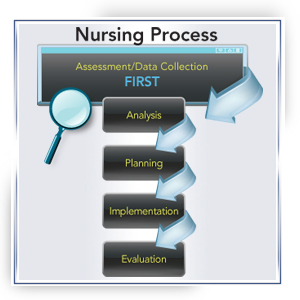 The nursing process is a problem solving process you can use to diagnose and treat the response of clients to actual and potential
alterations in health. The nursing process consists of four or five consecutive steps that include assessment/data collection,
analysis (when used by RNs), planning, implementation, and evaluation. The first steps of the nursing process take priority over
the latter steps - for example: assessment/data collection takes priority over other steps of the nursing process because you
must obtain all necessary data and information before being able to make a decision regarding what nursing action is appropriate to take.
The nursing process is a problem solving process you can use to diagnose and treat the response of clients to actual and potential
alterations in health. The nursing process consists of four or five consecutive steps that include assessment/data collection,
analysis (when used by RNs), planning, implementation, and evaluation. The first steps of the nursing process take priority over
the latter steps - for example: assessment/data collection takes priority over other steps of the nursing process because you
must obtain all necessary data and information before being able to make a decision regarding what nursing action is appropriate to take.
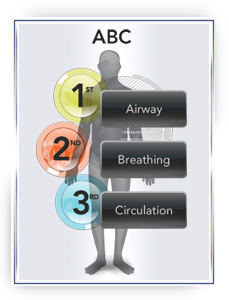 Assessment of a client's airway, breathing, and circulation, in that order, is the priority in regard to how the initial assessment of
a client should be done. This practice is often referred to assessing a client's "ABCs". Since airway, breathing, and circulation are
critical for survival, an alteration in one of these areas could indicate a threat to life or a need for resuscitation.
Assessment of a client's airway, breathing, and circulation, in that order, is the priority in regard to how the initial assessment of
a client should be done. This practice is often referred to assessing a client's "ABCs". Since airway, breathing, and circulation are
critical for survival, an alteration in one of these areas could indicate a threat to life or a need for resuscitation.
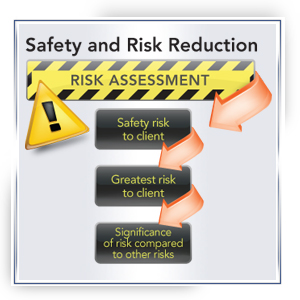 The safety and risk reduction priority-setting framework assigns priority to the factor or situation that poses the greatest safety
risk to the client. It also assigns priority to the factor or situation that poses the greatest risk to the client's physical and or
psychological well-being. When a client is facing several risks, the one that poses the greatest threat to the client as compared to
the other risks is the one that is deemed the highest priority.
The safety and risk reduction priority-setting framework assigns priority to the factor or situation that poses the greatest safety
risk to the client. It also assigns priority to the factor or situation that poses the greatest risk to the client's physical and or
psychological well-being. When a client is facing several risks, the one that poses the greatest threat to the client as compared to
the other risks is the one that is deemed the highest priority.
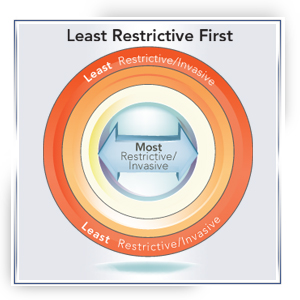 The least restrictive, least invasive priority-setting framework assigns priority to nursing interventions that are least restrictive
and least invasive to the client. The least restrictive priority-setting framework is used when caring for a client who is exhibiting
behaviors that could result in harm to either the client or the client's caregivers, or an intervention that will compromise the
natural barriers between the client and the environment that is being considered. When selecting an intervention using this framework,
however, you must also ensure that the nursing intervention selected will not put the client at risk for harm or injury.
The least restrictive, least invasive priority-setting framework assigns priority to nursing interventions that are least restrictive
and least invasive to the client. The least restrictive priority-setting framework is used when caring for a client who is exhibiting
behaviors that could result in harm to either the client or the client's caregivers, or an intervention that will compromise the
natural barriers between the client and the environment that is being considered. When selecting an intervention using this framework,
however, you must also ensure that the nursing intervention selected will not put the client at risk for harm or injury.
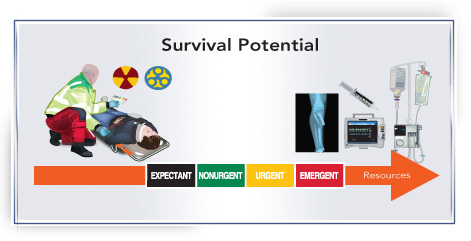 Survival potential is based on the chance a client has for survival during a mass casualty event when resources are limited. Appropriate
use of human and physical resources that will save the greatest number of lives is the goal. In order of highest to lowest priority are
Class 1/Emergent, Class 2/Urgent, Class 3/Nonurgent, and Class 4/Expectant.
Survival potential is based on the chance a client has for survival during a mass casualty event when resources are limited. Appropriate
use of human and physical resources that will save the greatest number of lives is the goal. In order of highest to lowest priority are
Class 1/Emergent, Class 2/Urgent, Class 3/Nonurgent, and Class 4/Expectant.
Acute vs. Chronic
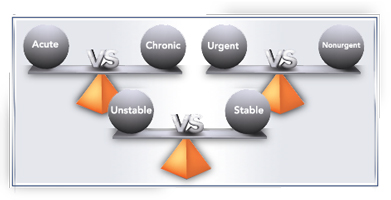 In the acute vs chronic alterations in health priority-setting framework, acute needs are usually given priority as they may pose more of
a threat to the client. Chronic needs usually develop over a period of time giving the body the opportunity to adjust to the alteration in
health. Thus chronic alterations - unless a complication is being experienced - are usually considered to be a lower priority.
In the acute vs chronic alterations in health priority-setting framework, acute needs are usually given priority as they may pose more of
a threat to the client. Chronic needs usually develop over a period of time giving the body the opportunity to adjust to the alteration in
health. Thus chronic alterations - unless a complication is being experienced - are usually considered to be a lower priority.
Urgent vs. Nonurgent
In the urgent vs nonurgent needs priority-setting framework, urgent needs are usually given priority because they pose more of a threat to
the client. Some needs fall into the urgent category because they relate to an intervention that needs to be done within a prescribed time frame.
The urgent vs nonurgent needs priority-setting framework is also applicable when the nurse is caring for a group of clients, and a determination
must be made in regard to which client has the most urgent need and should be attended to first.
Unstable vs. Stable
In the unstable vs stable client priority-setting framework, unstable clients are given priority because they have needs that pose a threat to the client's survival. Oftentimes, the client need that is life-threatening involves his or her airway, breathing, and/or circulatory status. Clients whose vital signs or laboratory values indicate a client may be at risk for becoming unstable should also be considered a higher priority than clients who are stable.
Critically Reading Test Items
The two main components of a test item are the stem and its options. The stem is the initial narrative that you must read to
determine the focus of the
item and the subsequent question that must be answered. The second part of the item is the options
from which you must select the correct answer.
The correct option is called the key and the incorrect options are called distractors.
Using test taking strategies can help you read a test item critically, enhancing your chance of selecting the correct option.
Scenario
 The scenario describes a client care-related situation. It provides information you should take into consideration when answering a test
item. It also provides a context for the scenario, as well as any data needed to correctly answer the item. The scenario is usually the
first 1 to 2 sentences of the stem.
The scenario describes a client care-related situation. It provides information you should take into consideration when answering a test
item. It also provides a context for the scenario, as well as any data needed to correctly answer the item. The scenario is usually the
first 1 to 2 sentences of the stem.
Question
 The question is usually the last sentence of the stem which you must answer based on the client care-related information provided in the
scenario. There are three types of questions: positively worded, negatively worded, and priority-setting questions.
The question is usually the last sentence of the stem which you must answer based on the client care-related information provided in the
scenario. There are three types of questions: positively worded, negatively worded, and priority-setting questions.
-
Positively worded questions
Positively worded questions ask you to select the option that correctly answers the question posed.

-
Negatively worded questions
Negatively worded questions ask you to select the option that indicates an incorrect action by the nurse.

-
Priority-setting questions
Priority-setting questions ask you to determine the best, first, or highest-priority action or finding based on a priority-setting framework.

Person of Focus
 The person of focus in the stem is the person who is the focus of nursing care in the scenario. This may be the client, a family member,
a community or group, or another nurse. It is important to determine who the person of focus is in the item because it may influence
which option is the correct option.
The person of focus in the stem is the person who is the focus of nursing care in the scenario. This may be the client, a family member,
a community or group, or another nurse. It is important to determine who the person of focus is in the item because it may influence
which option is the correct option.
Keywords
 Keywords help you identify important words or phrases in an item. The stem provides critical information that will help focus your
attention. It 's important to be able to recognize and identify keywords, because a wrong option is frequently a statement that could be
correct if the keywords were different. Keywords are found in both the scenario and question.
Keywords help you identify important words or phrases in an item. The stem provides critical information that will help focus your
attention. It 's important to be able to recognize and identify keywords, because a wrong option is frequently a statement that could be
correct if the keywords were different. Keywords are found in both the scenario and question.
Distractors
Distractors are the options that are incorrect and will distract you from the correct option. Distractors should be plausible so you have
to make a clinical judgment based on an analysis of the options using nursing knowledge. Distractors for priority-setting questions should
be viable, which means that all of the options are actions that would be appropriate for the nurse to take but one action is the first or
priority action or response by the nurse based on a priority-setting framework
Key
The option that provides the correct answer to the question is the key. Depending on whether the item has a positively or negatively worded question, the key may be a correct or incorrect action by the nurse.
- Traditional multiple choice items have one key and three plausible options
- Multiple select items have two or more keys
- Priority-setting items have only one key but four viable options.
Critically Read Item
Critical reading skills that will help you to correctly read the stem of an item include carefully reading the scenario for the item, identifying
the person of focus, determining what the question is asking, and identifying what type of question is being asked. This means is it a positively
or negatively worded question or a priority-setting question. And don't forget to identify the stem's keywords and refer back to them when reading
the item's options. Finally, use a method for eliminating incorrect options.
Eliminating Incorrect Options
There are several steps in regard to eliminating incorrect options.
-
Step 1
First, read all options carefully and assign a code to each option. Assign a plus sign to options that are *probably correct, assign a minus sign to options that are *probably incorrect, and assign a question mark to options that are *possibly correct. If any part of an option is incorrect, assign a minus sign.
-
Step 2
Then, interpret the assigned codes disregarding any options for which you assigned a minus sign. For options that you assigned a plus sign or question mark use the following guidelines to interpret your coding.
+ and ? = +
+ and ?? = +
+ and ??? = +
-
Step 3
When selecting the correct option ALWAYS GO WITH WHAT YOU KNOW and select the option you assigned a plus sign!!! Don't try to second-guess yourself. Even if you are not sure which is the correct option, go with what you know and make your best guess based on this coding system.
Use Appropriate Priority-Setting Framework
There are keywords that should clue you in to the fact that the question in the stem is asking for the priority answer. Some of these words include
first, next, priority action or finding, most important, best, and immediate. Critically reading the stem of the item while looking for keywords will
help you select the most appropriate priority-setting framework for the item.